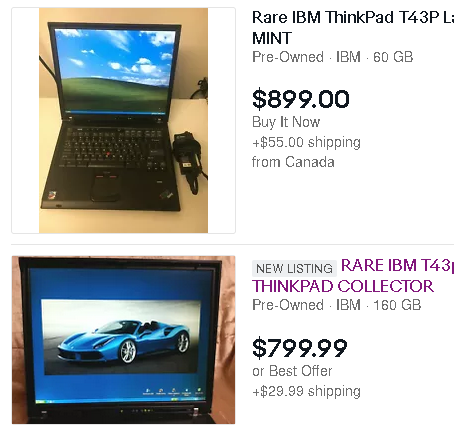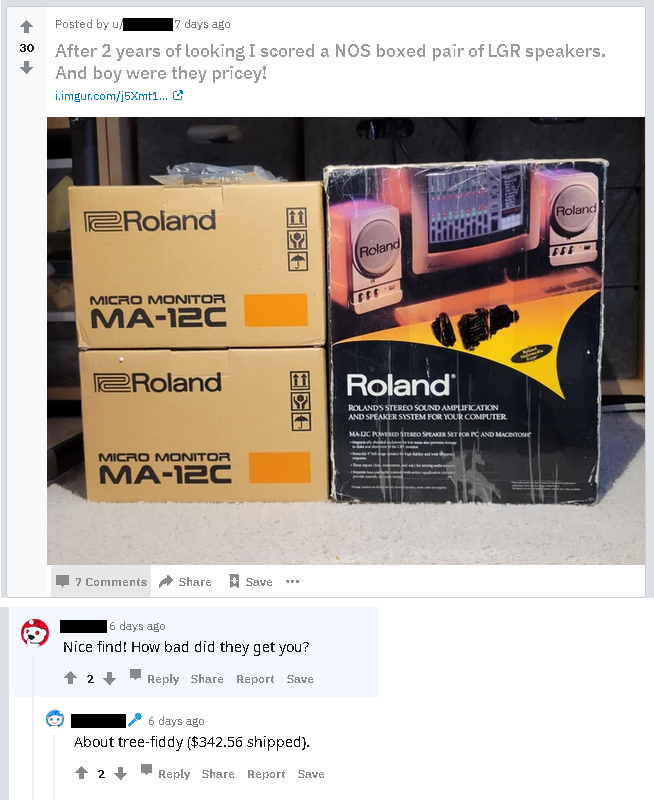|
|
| Last updated: 04/09/2021 |
|
This is an important one. Perhaps one of the most dystopian facets of the last several years is the bleak reality of retro gaming/computing, formerly a lighthearted and exciting hobby, having mutated into a woefully lucrative con industry. The exact same computers, video games, consoles, and CRT monitors/televisions that once littered curbsides, thrift stores, dumpsters, and yard sales for nearly free not even a decade ago, once typically discarded by the masses and procured by enthusiasts, now being price gouged for small fortunes on eBay and even dedicated stores while under the guise of being "rare" collectibles. You know, generic x86 whitebox PCs and all time best selling video games. Something every family in the 1990's - 2020's owned or still owns at least two of, and something that can be emulated with ease and for free. I believe this recent surge in prices can be attributed solely and entirely to one malevolent source - an artificial supply and demand incited by none other than opportunistic "Content Creators" within the hellscape that is YouTube's retro tech/gaming scene. Now, that's not to say there are no decent creators within the field, but the individuals I am primarily referring to are consistently tech-illiterate, self-centered, airheaded, and nostalgia-blind, yet somehow have secured a position as the proverbial "pillars"" of the community despite having likely never written a single line of code in their lives or are incapable of repairing the hardware they remain under the guise of being passionate about. I suppose by this I'm referring to maybe two or three channels in particular that seem to account for a vast majority of content within the field. I do not intend to gatekeep, although I find it a bit odd that some of the largest "creators" in this genre have never held a soldering iron. Personally, I enjoy content I can actually learn something from as opposed to yet another showcase of the same hardware without any technical insight. |
|
I'll begin with my qualms with the "retro computing" scene, or rather, its dystopian contemporary form.
Firstly, typical YouTube content within this genre consists mostly of either low effort Wikipedia recitations, superficial attributes such as case aesthetics and nostalgia, or yet another cliche video of yet another generic x86 IBM PC clone build running the ever so stale and tiny handful of DOS games, typically in the particularly price gouged and rather limited configuration of a i486 AT build or a Socket 7 Pentium system with the not so obligatory 3dfx Voodoo (Or two in SLI, depending on how deep your pockets are nowadays). And no, there is absolutely nothing innately wrong with this hardware configuration, I have systems like this myself that I adore. However, it is far from the only, exclusive way one can run MS DOS, Windows 9x, and their respective games and software, contrary to how this is deceitfully illustrated by at this point what I'd begin to refer to as propaganda. "B-But... What shall I ever do without glide!?" you may ask... Well, it's really as simple as the fact that wrappers exist, most games that relied on glide were patched two decades ago and perform even better under OpenGL or Direct3D, and slightly newer nvidia and ATI cards (A personal favorite of mine being the GeForce2 MX or MX 400, if you want to spend less than $15, even on eBay) will yield far better performance and flexibility than even the 3dfx Voodoo5. If you find a 3dfx card for cheap or free, by all means, use it - they're nice cards. However, exchanging an arm and a leg for one simply because YouTube or Reddit told you to is nothing short of asinine. Alas, the inevitable (and possibly intentional) result of such "content" is a colossal influx of clueless and uninformed novices pouring in from all sides, with zero prior knowledge, ready and willing to shell out hundreds of dollars for even the crustiest, smelliest, most generic 633mhz Celeron system without a hard drive, RAM, or a side panel, caked with dust, a barely functional CD-ROM drive along with the blurriest, most low-end, 1024x768 59hz 15" office CRT riddled with gaussing, convergence, and contrast issues after watching one mere video within this genre. Thus, making the half-decent hardware virtually unobtainable to those lower in our economic caste system, and the mediocre/low-end/damaged hardware nearly so. As I touched on earlier, yes it is actually still entirely possible to assemble or purchase a period correct x86 system even from eBay for a relatively decent price if you're hellbent on using bare metal and you know exactly what hardware to look for. The aforementioned PCI or AGP graphics cards coupled with Socket 462, 754, or hell, even 939 and 775 boards (Which will potentially allow you to use a PCI-E GPU, which is not recommended but may work out depending on your use case) will all cooperate more than fine with Windows 98 so long as there are compatible drivers, which is ultimately what it boils down to in most cases. Even a wide variety of thin client PCs that even sometimes have a single PCI or ISA slot make fantastic "retro" systems. Sound is another issue, and assuming you desire Adlib/OPL3 compatibility, PCI SoundBlaster Live! cards can still be easily acquired on even eBay for under $15 usually and work phenomenally, although the PCI Yamaha XG cards are my personal favorite as they're cheap, plentiful, and even offer a genuine OPL3 core on the chip. And with the vast diversity of such hardware, it cannot possibly be price gouged. The greatest part about a build like this is that unlike the cliche Pentium Voodoo build, you'll receive far better performance and flexibility, and be able to play games from the early DOS era all the way up to the early 2000's. If your board allows you to disable the cache and underclock your CPU, you may even be able to achieve i386/i486-tier performance with DOS games and software that are clock-dependent. Go ahead, attempt to play Half Life 2 on a Voodoo II - You simply will not, and cannot. Alas, these are the sorts of tips that are kept from the uninformed who will watch one Wikipedia recitation in a Duke Nukem voice accompanied by the occasional creepy groan. With that said, I strongly implore you to always consult local boomers, IT departments, recycling centers, post a wanted ad to Craigslist, and scour curbsides and dumpsters before going such a route, though. I still regularly find entire systems, CRTs, and more via these means. As for graphics cards and other components, look up part numbers and OEM names on eBay rather than the card's formal name to find incoherent boomer listings for cheap. RISC Unix workstations and older, unique architectures such as Amiga, Atari ST, Commodore 64, Apple II, etc. aren't safe either, and tend to demand an even larger price tag nowadays. These non-x86 systems were the first to receive this treatment, even before the generic Wintel boxes of the late 90's and early 00's, and went from being nearly free, to expensive, to practically unobtainable in less than a decade. As someone who owns a number of SGI workstations, peripherals, a monitor, and accessories (Which were all acquired for the more than fair price of free!), I fear the day at which my systems perish in a way that truly is beyond repair, as replacing parts for them is now impossible. SGI RAM alone sells for hundreds of dollars. MIDI Synth modules also have fallen victim to a similar fate in recent years, as there seems to have also been a recent interest in non-musicians hoarding various modules for use with the aforementioned stale handful of DOS games. I can fully understand this with modules such as the Roland SC-55, SC-88, and MT-32, but I see no point in roping other modules into this scam industry. As a musician of 15+ years who uses these legacy synths daily, I find this particularly disheartening. If what you seek is merely to run legacy games and software, Dosbox is your friend. Even early versions of DOS-based Windows will run under Dosbox. Windows 2000 is also one of the greatest and backwards compatible versions of Windows and runs in VMs better than any other version in my experience. Please, for the love of God, emulate, create a virtual machine, or practice the aforementioned tips when searching for a retro computer if you insist on running these operating systems on bare metal. |
|
Now, for my qualms with the retro console gaming "scene".
If you thought the absolute state of the retro computing scene was ridiculous enough, the current state of the retro console gaming scene honestly puts it to shame in terms of sheer absurdity, especially considering as physical console games are individual purchases if you choose to use real hardware and authentic, physical copies of games over emulation, which is a debate that in my opinion has spawned some of the most preposterous examples of elitism in the community. We'll get to that shortly, though. I fondly remember the days of thrift stores selling entire bags of SNES, N64, NES, Genesis, etc. games for under $5.00, Gamecube games lumped in with the DVDs for under a dollar a piece, and various consoles lounging in the electronics or toys section for two or three dollars. N64 controllers hanging in the cords section for $0.69, Gameboys in small bags for under a couple dollars lumped in with the flip phones of yesteryear, entire boxed console sets with games, cables, and controllers at yard sales for $15. eBay wasn't much different, with consoles and handhelds generally under $20, and games typically under $15. Those days are long since over. If you see anything even remotely related to Nintendo, Sega, or even video games as an entire category at a contemporary thrift store, it is immediately put behind a glass case and a price tag comparable to that of the contemporary eBay market for consoles and games alike. At the time I write this, it isn't uncommon for games and consoles of the retro variety to sell well above their original retail prices - the more popular Gamecube games selling for over $100, Pokemon games on the various Gameboy incarnations selling for anywhere from $100 - $300 for a loose copy with a dead battery, the more popular N64 games nearing $100 a piece, and well, we all know how the SNES market is *cough* Earthbound *cough*. Consoles such as the N64 nearing $300 for a mere system and controller, and SNES consoles sitting around $250. Theoretically, if someone just wanted to play some Pokemon Emerald on a Gameboy Advance SP without any knowledge of emulators and decided to buy just those two items alone, that'd be a $500.00-ish investment. You could purchase around 10 used, scratchd up Gamecube games, or acquire a running vehicle. Optical discs or stickers and ROM chips easily pawned for enough to place a sizeable down payment on a house, when there exists an accurate emulator for just about every popular console in existence as well as a vast variety of flash carts capable of running practically every console game in existence for little to no cost. See for yourself, I suppose. This brings me to the ever so pretentious war on emulation/flash carts, perpetuated only by those who reside within a higher level of our economic caste system. You know, the neckbeards endless gloating over their entire wall of boxed N64 systems in assorted colors... A diminutive Sony BVM as the centerpiece of their living room surrounded by every console known to man... Adjacent shelves filled to the brim with miles upon miles of cartridges... Gamecube controllers of every color and variation merely hung on the wall as trinkets, never to be used... Perhaps even a Nintendo kiosk or something, in a room encompassed by literal piles of merchandise, plushies, neon signs, etc. Bleh. No, you are not a "poser" for emulating. However, if you truly do insist on purchasing a console due to the emulators not being "accurate" or "the experience" not being the same, I will strongly recommend you invest in a flash cart of some sort. Preferably one of the Chinese fakes, as they're just as good as the official ones. This way, you get the perks of playing on a real console without having to shell out thousands of dollars (Yes, thousands, if you want more than like, a dozen decent games) for what is essentially once again, mere ROM chips and stickers. At the time I write this, the Japanese retro gaming market is still exactly the way the Western world's was not even a decade ago. Case in point. |
|
Lastly, I wish to voice my qualms with the current state of CRT gaming, particularly with the Sony PVM/BVM meme.
To begin, let's deduce why these mass produced video monitors once recycled or given away for free by the pallette by thousands of broadcast studios were memed to hell by a handful of YouTubers and thus have become essentially an e-peen measuring status symbol, recently fetching between $2000.00 - $3000.00 for the 20"+ models, around $600.00 - $1000.00 for the 14" - 20" models, and anywhere between $300.00 - $600.00 for the 8" and 9" models. Yes, 8-9". Really, it boils down simply to the fact that some models are equipped with with RGB inputs; something available in the form of SCART on just about any PAL consumer TV. Sure, you could probably name a few other ways as to why these tubes are particularly high quality, but I feel those attributes are irrelevant as the primary selling point and reason these monitors have garnered the reputation they have is the ability to accept RGB inputs. However, I feel the cons of such monitors when it comes to retro gaming strongly outweigh the pros, renders the exorbitant price they now demand as well as the propaganda in regards to them being the greatest (And potentially most expensive) retro gaming purchase one can possibly make even more absurd. Let's start off with the size - Sony PVMs are small. Really small, and for a good reason. They were designed to be sat on a desk only a couple feet from your eyes as a way to view sources and preview/program output in conjunction with linear video editing equipment, or in a CCTV system. Note: Not for media consumption or gaming; the most commonly available models (That still fetch a ridiculous sum on eBay) possess 8 or 9 inch tubes, and 14" if you're lucky. Regardless of the infinite layers of mental gymnastics one could attempt to go through in order to justfify this being optimal for gaming of all things, there is absolutely no way in this plane of existence that I could genuinely imagine having an enjoyable experience gaming on even a 14" tube all the way from the couch. Even if the RGB does provide an increase in picture quality, I guarantee you will not under any circumstances be able to notice it from that far away. I always find it amusing to see a tiny PVM or PVM as the centerpiece of a game room above a dozen consoles, often times with the PVM being smaller than the consoles themselves. Frankly, you might as well be gaming on a postage stamp. Another thing I find particularly amusing is that only some PVM models come equipped RGB inputs, yet the ones that don't still demand the same premium and are still routinely purchased by gullible ledditors. If the entire PVM meme is for the most part based upon the ability to accept RGB, then what sets a PVM without such a feature apart from any other consumer set with composite and S-Video aside from the fact that they're significantly smaller and usually don't have any sort of audio input, and thus inferior? Not much else, really. There are even models that lack S-Video inputs that demand the exact same premium, and even black and white monochrome CCTV monitor versions that are still regularly advertised as "great for retro gaming". Ultimately, just about any consumer CRT television set with composite and S-Video that can still be easily found for free will do more than fine, and in fact, was the way the games were intended to be played - and with an optimal screen size and decent integrated speakers, too. Hell, even RF can look fine provided you have the right modulator. And if it was truly about nostalgia, it is more than safe to say that this fits the bill far more accurately as I guarantee you that nobody and I mean nobody played their games on a PVM/BVM growing up. No, shelling out $2500.00 on a 20" BVM will not under any circumstances make the game more fun. As the owner of basically the JVC equivalent of a PVM, RGB inputs and all, I do not use it for gaming as it simply is not an optimal experience. I do, however, have it hooked up to a bunch of my linear video editing gear. |
|
|

|

|

|

|

|

|

|
And last but not least...

|

